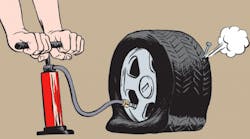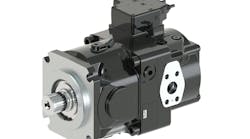Improving Compressed Air System Efficiency: Part 9
Why should the air in compressed air systems be properly prepared? The answer is simple. Dust and other solid contaminant particles, water and oil vapor, and oil aerosols are present in all ambient air that enters air compressors. The compression process removes none of these. Instead, it concentrates them. A cubic foot of compressed air exiting a compressor at 100 psi contains all the contaminants of seven cubic feet of ambient air that were drawn into the compressor. If not removed, these contaminants will eventually cause trouble downstream.
Detriments of dirt, water, and oil in compressed air
Solid particulates are the most obvious contaminants. All air is loaded with millions of dirt particles. Air in industrial environments is likely to contain even more particulates because of surrounding manufacturing and assembly debris. Also, as compressors wear, they introduce metal, carbon, and Teflon particles into the air stream passing through them, further raising the particulate content.
Even at only 15% ambient relative humidity, the water vapor content in compressed air is very high. The natural heat of compression raises the air temperature, allowing it to still carry this water in vapor form. But as heat is lost from the downstream system by radiation and convection, water can condense inside the air system. Condensation is the formation of a liquid from gaseous matter when the temperature falls below the gas's dew point. An example of this is when your breath fogs your windshield on a cold day or water droplets form on the outside of your iced tea glass on a hot summer day.
Another contaminant in compressed air is oil, which can occur as an aerosol (a suspension of microscopic particles) or as a vapor. Oil that finds its way into a compressed air system often comes from the compressor itself, if the compressor is a lubricated type.
All of these contaminants mean trouble for a compressed air system. Some of the problems that result are:
• blocked orifices
• sticking valves
• leaks from seal damage
• sluggish operation of actuators and air tools
• clogged instrumentation
• damaged components when liquid water washes away lubrication, and
• freezing of outdoor lines during cold weather.
Any of the problems can interfere with production - either by slowing cycle speed, actually spoiling products, or downtime to perform maintenance and repair.
Air preparation to rid the air stream of water, particulate matter, and oils is essential to an efficient, well-engineered compressed air system. Preparing compressed air properly will reduce maintenance on equipment, improve the quality of the product, and reduce downtime. The cost of preparing compressed air is much less than the cost of fixing the damage caused by untreated air.
Filtration and drying
Solid particulate collection and removal is accomplished by passing air through a medium such as paper or fiber, which acts as a filter upon which particles from the air are deposited. This particulate is then removed either by replacing the medium or in some way cleaning the medium (particulate filters).
Such mechanical methods of air preparation only work on contaminants which are in a liquid or solid form. If the contaminants are in the form of a vapor, they first must be condensed into a liquid, which then can be removed by a variety of methods.
In a compressed air system, controlled condensation can occur in aftercoolers and several types of dryers. These components lower the temperature of the compressed air below the pressure dew point. The liquid is collected by separators within the aftercooler or refrigerated dryer, or may also be collected by downstream coalescing filters. Once collected, the liquid contaminants are drained away.
Chemical drying methods — Chemical methods of vapor removal are divided into two types: adsorption and absorption. Adsorption occurs when the molecules of a gas adhere to the surface of a desiccant material, such as those used in a desiccant dryer. In a desiccant dryer, the water vapor is removed by heating the desiccant to drive off moisture, allowing the desiccant to be reused. This type is not limited to the freezing point of the condensate &emdash; and, therefore, is used in applications where dew points below freezing are necessary.
Absorption is the combining of the molecules of a gas with the molecules of the absorbing material. The absorption type (deliquescent) requires that the material be continuously replaced as it is consumed when forming a brine solution. (Absorption is also used with gas phase filtration.)
Membrane drying — In this method, pressurized air flows through a collection of membrane tubes or hollow fibers in a chamber where the exterior of the tubes or fibers is at atmospheric pressure. The membrane material allows water molecules to pass through to the low-pressure side while restricting the passage of the other molecules that make up air (mainly nitrogen and oxygen). The process is limited by the relative humidity of the air flowing over the atmospheric side of the membrane.
Each molecule of water vapor that passes through the membrane must be carried away by a flow of gas on the atmospheric side. These membranes are extremely sensitive to contamination, but with proper prefiltration, they have a long service life. The number of tubes or fibers determine the flow capacity of a membrane dryer. Advantages include low maintenance, because there are no moving parts, and efficient operation, as they require no electricity to operate.
Microorganisms — The presence of liquid water is an issue in most compressed-air systems &emdash; not just because of its negative impact on production equipment, but because in a liquid state it can be a carrier of other contaminants. The oxygen-rich nature of compressed air &emdash; combined with water and the right temperature &emdash; can turn an air system into an incubator for microorganisms. In the long run, the air-preparation method must be be selected in the light of the particular ambient atmosphere and the application of the compressed air.
Types of air quality
Many air quality standards are required by industry or law, although they do not exist in any particular standards collectively. Some are stated formally by a variety of associations; others are understood verbally or traditionally. The following list covers almost all compressed air systems.
Plant air — There should be no liquid water or lubricants in the system. Particulates to the point of use should be <10 µm. There are no existing standards.
Instrument air — There should be no liquid water in the system. Pressure dew point is equal to or lower than 18° F below the lowest ambient temperature that the piping is exposed to. Hydrocarbons should be limited to <1 ppm condensables by volume, and particulates to the point of use <1 µm. The Instrument Society of America recognizes their ISA S7.3 standard.
CDA 100 — This standard is recognized by the microelectronics industry where air is used in contact with electronics components for cleaning or vapor absorption. Prior to CDA100, bottled and bulk nitrogen was used. It has been the intent to replace nitrogen with CDA 100 where the presence of oxygen is not a problem. There should be no liquid water in the system, the pressure dew point should be equal to or lower than –78° F, and hydrocarbons should be limited to no condensables. Particulate to the point of use should be less than 0.1 µm.
H1F and H1 FDA — The H1F standard applies where compressed air comes into contact with food in process. The standard is relative to the compressor lubricant having incidental contact. The standard is that there will be less than1 ppm of compressor lubricant per million parts of food. H1 standards are for the quality of compressor lubricants that may be used in a food processing environment, but may not have incidental contact with the food. The Food & Drug Administration publishes these standards.
Many other individual industry standards deal specifically with reactants to their process. One such requirement is no hydrocarbons or oils in any physical phase or state in a brewery. In aerospace testing, moisture content is typically measured as grains of moisture per pound of air.
Breathing air — There should be no liquid water in the system. Pressure dew point should be equal to or higher than 42° F, hydrocarbons limited to condensables <1 ppm, and carbon monoxide limited to <10 ppm. The carbon monoxide standard should be combined to include other potential inlet gases such as hydrogen sulfide, nitrous oxide, and other process byproducts, including some particulates (such as cotton dust as an example), which might be present in the atmosphere specific to the inlet of the system. Particulate to the point of use should be <1 µm. The Compressed Air & Gas Institute recognizes their Grade D standard. There is also a combined standard in OSHA regulation 29CFR1910 with Grade D. 29CFR1910 also includes standards for test and measurement of air quality.
Sterile air — There should be no liquid water in the system. Hydrocarbons should be limited to no condensables, microorganisms should be limited to less than 0.1 µm absolute, and particulate to the point of use: <0.1 µm. Final filter cartridges should be flash cleaned in place with process steam on a regular basis. This requires two in-situ filters with automatic valving, so that one filter can be cleaned while the other is on line. There is no existing standard.
R. Scot Foss is president of Plant Air Technology, Charlotte, N.C., which specializes in air system auditing and design. This series of articles is based on his book, Compressed Air System Solution Series. To order a copy, click here.

